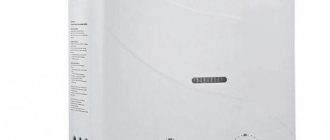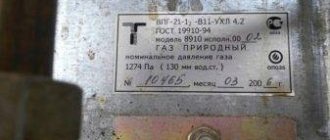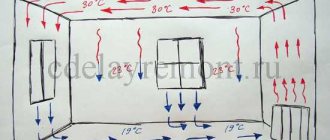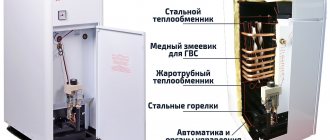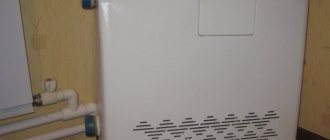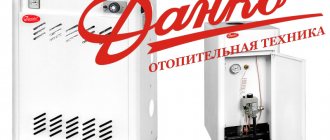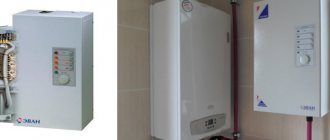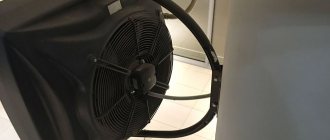Today, almost no piece of household engineering equipment can do without a functional control system. Boilers, heaters and underfloor heating systems especially require efficient and accurate means of monitoring and adjusting operating parameters. Moreover, this task is not always achieved through electronics. Even if in partial form, the mechanical thermostat is fully justified. Firstly, this is a familiar configuration of a control tool, and secondly, in some versions it benefits from reliability and cost.
General information about mechanical thermostats
Most often, such devices are small-sized devices with one or more control elements. The latter can be buttons, levers and round knobs in the form of washers. The panels also provide indicators that display basic information about performance indicators. As for the areas of operation, a mechanical thermostat is usually positioned as a universal device, but there are separate modifications designed for special application conditions. For example, equipment that must be installed on the outside is additionally protected by insulating coatings. Special versions also include combined two-zone models, which can be used to service several pieces of equipment.
Thermostat
A device for regulating and maintaining a certain temperature in heating and cooling equipment is called a thermostat. They are widely used in various fields. such as monitoring heating devices in small and large rooms, for example, apartments, or industrial facilities. The devices are installed on freezing, cooling, and heating devices of varying power. Despite the fact that the products are different, the devices that are installed on them have an identical design, and the essence of their work is the same.
Purpose and principle of operation
Turning on, off and switching the temperatures of heating devices and systems is the main purpose of the thermostat. Thanks to this, the user can maintain the necessary heat in air, water, and various surfaces.
Devices designed for these purposes operate on the same principle: due to the built-in temperature sensor, they receive data on the external temperature, after which they automatically determine when to turn on or off. In order to avoid malfunction, the device should be installed away from the direct influence of devices in the room that are equipped with heating elements. Since they will mistakenly create a different temperature near the sensor, which will cause malfunctions.
Types of devices
Manufacturers classify regulators according to the nature of installation, place of operation and the presence of a programmer function. Installation can be carried out by insertion or overhead method. The place of operation can be the floor, walls or suspended structure. Programmers, in turn, are rarely used in mechanical devices, but there are such modifications. In addition, the mechanical thermostat differs in stylistic properties. So, according to their shape, we can distinguish round, rectangular and triangular models. From the point of view of installation possibilities and ease of use, the choice according to this criterion is of little importance. Most often, attention is paid to external features when assessing the design suitability of the device for the place of use.
Main characteristics
Different models are distinguished by a wide range of operational characteristics, including the number of working zones, load power, range of temperatures available for coverage, etc. The number of working zones or channels in standard models can reach 2, but there are also highly specialized modifications in which servicing more than 10 separate objects. In terms of power, mechanical thermostats for heating have a potential in the range of 3-4 kW. Typically, as the number of zones increases, the load also increases. An important operating parameter is the temperature spectrum. For simple regulators, it is a narrow corridor on average from 5 to 30°C. However, when operating powerful boilers with high heat output, a wider range should be provided - up to 60-70°C. Also, to determine accuracy, pay attention to the error of the regulators. It is important to understand that mechanical devices are initially inferior to electronic digital analogues in this indicator. On average, deviations can reach 2-3°C.
The best thermostat models
Manufacturers offer customers a wide selection of thermostats of different types, functionality and price categories. Based on reviews from users and experts, you can choose the highest quality, reliable models among them.
Teplolux TR 520
Electronic programmable model. Inexpensive and easy-to-use thermostat for electric and water heated floors. It has a graphic display that shows the selected programs and the degree of heating in the room at a given minute.
The temperature sensor and user-friendly interface make settings easy. Main characteristics of the device:
- minimum temperature level - 5 degrees, maximum - 35;
- power - 3500 W;
- communication current - 16 A;
- Warranty period - 3 years.
Model advantages and disadvantages:
- low price;
- beautiful display;
- the ability to adjust the heating level for any day;
- “anti-freeze” mode;
- availability of air temperature adjustment.
- After disconnecting, you need to configure it again.
National comfort 711
Inexpensive model with rich equipment. Includes floor and air temperature sensor, large graphic display with backlight. The regulator has a self-diagnosis function, its results are reflected on the screen.
The warranty period for the device is 1 year. The device allows you to save up to 30% of the resource.
The disadvantage of the model is low protection, so it is not recommended to choose this device for a bath or shower. Problems may also arise when pressing the buttons, since they are not located very well.
Varmel RTC 70.26
Electronic wired mechanical thermostat for electrical and water systems. Operates at a minimum temperature of 5 degrees, maximum - 40. Permissible load level - 3600 W. Warranty - 1 year. Installation is carried out in an installation box.
Advantages and disadvantages:
- convenient on and off buttons;
- the presence of a remote-type sensor with a 3-meter wire.
- makes a clicking sound when switching.
Thermo Thermoreg TI-200
A simple and cheap mechanical device. This is a cheap device with an indicator and a temperature sensor. With it you can quite accurately adjust the desired heating level and maintain it. The heating indicator is set on a scale, and the presence of a two-pole switch makes it easy to turn off the regulator.
Operating temperature from 5 to 40 degrees. Maximum load - 3600 W. Guaranteed service life 3 years.
Pros and cons of the model:
- Compactness;
- low cost;
- ease of operation;
- the presence of an anti-freeze function.
- inability to adjust heating by day of the week, lack of display.
Terneo SX
“Smart” thermostat equipped with a touch panel and temperature sensors. It is chosen when remote control is required, as it can be controlled via a smartphone. The interface is simple, making setup easy. Hysteresis can be adjusted to reduce the number of switches on and off. Installation is simple - it is installed in a metal box on the wall.
Terneo SX has a number of useful features:
- timer;
- protection from children;
- departure mode.
Main characteristics:
- temperature level from +5 to +45;
- thermostat power 3000 W;
- Warranty period - 3 years.
The advantages include low price, ease of operation, fast response of the screen to touch, and the ability to track statistical data on operation and electricity consumption. Disadvantages - difficult connection to a smartphone, low-quality plastic.
SpyHeat ETL-308B
SpyHeat ETL-308B
Compact mechanical model, easy to operate, high quality, but inexpensive. It has a pleasant appearance and works for a long time without interruption. The case is equipped with a temperature switch and indicator. The setting is carried out by turning the switch.
Model characteristics:
- minimum temperature - 15 degrees, upper limit - 35;
- maximum power - 3600 W;
- there is a temperature sensor;
- service life - 2 years.
The disadvantage is a possible clicking sound when the heating relay is activated.
Rexant R70XT
Compact mechanical wired thermostat with simple controls. The switch operates smoothly, which allows you to change the heating degree by one division. The case is equipped with a system power-on indicator. The device is mounted in a distribution box.
Device characteristics:
- adjustment within +5 - +35 degrees;
- power – 3500 W;
- Warranty period - 1 year.
Nest Learning Thermostat 3.0
Nest Learning Thermostat 3.0
This model is the third generation of this type. Externally, it is no different, only it has a larger disk size and higher resolution (320X320 pixels).
The device is equipped with a large display and new functions:
- autoschedule;
- programming;
- auto shutdown;
- notification in case of violation of the regime.
Management is simple, possible with a smartphone via the Internet. Installation is also quite simple. Warranty - 2 years. The only downside is the high price.
Menred RTC 70.26
Inexpensive thermostat for mechanical electric floors with hidden installation and remote sensor. Wired control, with the ability to regulate floor heating.
Characteristics:
- Maximum load - 3600 W;
- temperature limit – from +5 to 40 degrees;
- warranty - 3 years.
The thermostat is equipped with a light indication. Installation of the device is simple; it is installed in a mounting box.
Grand Meyer HW500
A universal, inexpensive electronic model of a programmable type. Controlled by buttons, they can be locked. Has several modes. Equipped with temperature sensors - built-in and wired.
Specifications:
- operating temperature fluctuations – from + 5 to + 35;
- power 3600 W;
- communication current 16 Amp;
- warranty period 2 years.
The disadvantages of this model include clicks when turned on and the lack of locking when the mode is on.
Electrolux ETA-16
A device with a small display and a minimum number of icons. The screen glows brightly and lights up when you touch any button. The interface is clear, it is easy to set the regulator to turn off, set and maintain heating at a given level. The device is equipped with a temperature sensor.
Characteristics:
- temperature setting in the range from +5 to + 50 degrees;
- permissible power - 3500 W;
- Warranty period - 3 years.
Caleo 520
A surface-mounted device with a control sensor. It has a backlit display that shows the temperature. Equipped with a keypad lock function.
Main characteristics:
- temperature range from 0 to 40 degrees;
- Warranty period - 2 years.
Advantages of the model:
- easy setup;
- ease of use;
- low power consumption;
- modern design;
- low price.
Disadvantages noted by users are the clicking of the relay during operation.
Almac IMA-1.0
Modern, electronic, inexpensive device of high quality assembly. Equipped with temperature sensors - portable and built-in. A positive feature is that the hysteresis can be adjusted; the lower and upper temperature limits are set with high accuracy.
Specifications:
- maximum temperatures - from -50 to +110 degrees;
- power - 3600 W;
- warranty - 1 year.
Reviews of the T6360 model from Honeywell
One might say, a basic model representing the middle class of devices of this kind. Users note the versatility of its use in terms of combination with various executive systems. For example, the regulator is connected to pumps, boiler units, valves, home heaters and other equipment. As for reliability, the model as a whole receives more positive reviews. The fact is that the mechanical thermostat from Honeywell, in its design, is focused on sensitive perception of the slightest changes in the environment. This allows you to activate the currently necessary automatic safety systems that prevent device failure. The user learns about functional processes through a panel with indicators. Owners emphasize the ergonomics of the interface and the strength of the case.
Classification of thermostats
There is a large assortment of thermostats on store shelves, which allows the buyer to choose the appropriate device for any heating system. The devices differ in purpose and design and are combined with various heating systems and heating systems. Devices are classified according to several criteria, including:
- Technical capabilities, depending on them, the unit is divided into simple, designed only to maintain the set temperature, and programmable. One of the most expensive types are considered programmable; they provide several modes and programs for control. They allow you to constantly monitor heating systems in order to create comfortable conditions and be able to save energy resources. Such devices are equipped with a Wi-Fi system, which makes it possible to control and manage them via mobile devices.
- The number of channels can be single-channel, these are suitable for automatic control and temperature setting, and are light in weight. Multichannel suitable for standard sensors used in manufacturing and agriculture.
- Sizes: Devices come in compact, large and large sizes.
- Purpose: to maintain the degree of heat of the floor, air, or both at the same time.
- Mounting methods, wired, are connected by wires that transmit a signal from the thermostat to the device. Wireless models are radio-controlled, and their cost is considered the highest. Such regulators do not have extra wires and are ideal for those who do not want to spoil the situation with extra cables, as well as additional sockets. The models are endowed with certain functions, which makes them excellent assistants in creating a suitable microclimate in the house and more.
The classification does not end there; thermostats are also divided according to the type of sensor:
- mechanical;
- electronic.
Mechanical
The simplest, but despite this, the most reliable models with mechanical control. All settings are carried out manually, are intended for setting up heating systems and differ in the contents of the bellows. So, there are several types of mechanical devices:
- liquid;
- gas-filled.
The first type is characterized by low cost, and the second type is reliable. Gas-filled regulators are endowed with good speed and smoothness in changing temperature indicators. And mechanical ones are endowed with greater accuracy when transmitting pressure to the rod. By their design, such devices are considered the simplest, and are found on most household appliances, such as:
- Cookers, irons, heaters, the design of the devices is simple and consists of a bimetallic plate and a contact group. The working process is that when heated, the plate bends and opens the group, after which the electricity stops flowing, then when it cools down it returns to its previous position, closing the contact back.
- Boilers and other electrical appliances with a more complex design. The principle of operation in them is slightly different; the property of expansion of materials under the influence of temperatures is taken as a basis. More precisely, such regulators consist of a tube with a substance inside, which is placed in water; after heating, it transfers heat through the tube to the substance inside, then it expands under the influence of elevated degrees, closing or opening the contact group.
This category of thermostats has some advantages:
- reliable;
- resistant to possible voltage interruptions;
- not susceptible to malfunctions in the operation of the device itself;
- work at low degrees and their sharp changes;
- easy to operate;
- have a long service life.
And the cons:
- since the setup is done manually, regular adjustments will be required to clarify the data;
- small amount of function;
- there is an inaccuracy in the readings, which is approximately 4-5 degrees.
Models in this category are not only easy to use, but also have an affordable price.
Electronic
Electronically controlled designs have a higher cost, but there is no need to adjust their operation. Such regulators smoothly change parameters independently even when weather conditions outside change. For greater ease of use, manufacturers have provided a control panel, and on the device itself there is a small display on which all the necessary information is displayed. The electronic display itself can be push-button or touch-sensitive.
The advantages of such models include:
- wide choice of installations;
- products are produced in different design solutions;
- allows you to save electricity;
- has high accuracy;
- effective work;
- safe to use.
The disadvantages include:
- the cost is an order of magnitude higher than that of mechanical ones;
- and the possibility of electronic malfunctions.
Electronic regulators are often an integral part of a smart home system.
Temperature regulators can be installed not only inside, but also outside the room; outdoor or weather models are called thermostats.
Reviews of the thermostat DAIRE TR-TA2
This option is more likely to suit those who use low-power heating equipment in the apartment. In the line of entry-level thermostats, this is one of the best representatives. The development from DAIRE, according to many users, is beneficial in that it not only allows you to adjust the temperature to a certain level and maintain it with a high degree of accuracy, but is also able to optimize energy costs. On the other hand, the model is not characterized by a large coverage of operating temperatures. Therefore, if you need a mechanical thermostat for a heated floor or a small convector, then this purchase will justify itself, but it will hardly be useful in servicing a massive boiler installation. This disadvantage is compensated by convenient control and a high resource of the control elements, which is also confirmed by users. According to the manufacturer, the device can withstand about 10 thousand clicks.
Feedback on the Heat-PRO RTC-70 model
This is a special device for controlling the operating parameters of electric heated floor coverings. As practice shows, the model copes well with network loads, provides relatively accurate heating indicators, requires minimal power supply and is durable. However, many owners point to modest functionality and a minimum of regulation tools. For a typical heated floor system, this mechanical thermostat is suitable, but it may not fully reveal the capabilities of expensive, powerful systems. But there are no complaints about physical reliability - despite its laconic shape and compact dimensions, the model has a durable body and tightly integrated regulators.
What they say about the Caleo UTH-130 model
One of the premium models, which, although it does not offer special functionality, is noticeably different in basic performance characteristics from the analogues presented below. First of all, many owners point out the possibility of using the device in combination with powerful heating equipment. This is the optimal mechanical thermostat for a solid fuel boiler or a productive water heating installation. Again, the owners of the device testify that over a wide temperature range it shows high accuracy of regulation. As for other advantages, communication capabilities are also noted. In particular, the user can control the device using a remote sensor with an indication on a two-meter wire.
Connecting the thermostat
In general, the operation of installing a thermostat is similar to installing conventional sockets. At least this applies to the physical integration of the device into the wall. There are also overhead models that do not require intervention in the wall niche. The direct connection is made through three lines - this is the power wire, the cable from the heating actuator and the circuit from the sensor that monitors the air temperature. When connecting a mechanical thermostat, it is important not to confuse the types of wires. Typically, white or black markings indicate phase, blue markings indicate zero, and grounding is performed through yellow-green wires. True, to be sure, you should still refer to the instructions with the diagram attached to the thermostat of a particular model.
Types of thermostats
The classification of all thermostats is based on the principle of control and configuration of these devices. Each variety has some advantages and disadvantages.
Mechanical
A device that is easy to set up and operate without electrical components. The function of a temperature sensor in it is usually performed by a bimetallic plate. When cold, it closes the contacts of the heating mats. As the temperature in the room increases, it bends and disconnects the electrical circuit, as a result of which the floor heating stops.
The mechanical device is adjusted using a wheel, which can be rotated to adjust the temperature. Despite their simplicity, mechanical thermostats have a strong hold on the market.
It has a number of advantages and disadvantages:
- low price.
- ease of operation.
- ability to work at low temperatures.
- reliability;
- independence from voltage surges;
- long service life;
- automatic switching on after a power outage.
- minimal functionality;
- lack of remote control capability;
- large error in tinctures;
- the presence of fairly loud clicks when bending the bimetallic plate.
Electronic
This type of thermostat is similar to mechanical types in terms of operation and functionality. The device is equipped with a digital display (on which indicators are displayed) and a heated floor and air temperature sensor. The parameters are set manually. The user can control the temperature with an accuracy of 0.5 degrees.
Device advantages and disadvantages:
- flexible regulatory program;
- presence of a remote control;
- ability to connect to other control systems.
- high cost and difficulty of self-regulation.
Programmable
The main difference between programmable thermostats and conventional electronic ones is the expanded functionality of the control microcircuit. This device can be programmed to turn on at a certain time of the day, and several heating modes can be set on it: minimal, optimal and economical.
Modern programmable models may provide a remote control function from a smartphone via Wi-Fi. Some manufacturers of thermostats produce their own applications for smartphones, by installing which you can configure the equipment from your gadget.
The disadvantages of this device include the high cost and difficulty of setting up in the absence of skills in handling the equipment. Otherwise, the pros and cons of programmable thermostats are the same as conventional electronic ones.
In electronic and programmable thermostats, internal components can be divided into two blocks: main and mobile. Electrical cables are connected to the main box and wired temperature sensors are connected. It can be placed in any remote location of the room, which makes installation easier.
The battery-powered mobile unit is used as a remote control. It can lie on a table or hang on the wall. Additionally, the consoles can be equipped with external temperature sensors that measure the ambient air temperature. Such devices are convenient because they allow you to hide the adjustment mechanism from children.
How to choose the optimal model?
Before purchasing, you should draw up a list of mandatory requirements for the regulator for the installed equipment. First of all, the choice is made based on the load power - it should be sufficient to work with a specific heating equipment. Next, the connection features are taken into account. It is important to evaluate the conditions under which the installation will be carried out - for example, using the overhead principle or through insertion. Thus, a mechanical thermostat for a heated floor is usually installed in the wall, but if we are talking about a boiler station, then additional devices for wall-mounted installation may be required. You should not ignore possible threats in terms of external influences on the device. Both the risk of physical damage and the likelihood of moisture entering the housing are taken into account. Accordingly, to ensure safe operation of the regulator in conditions with such risks, it would be useful to turn to models equipped with protective insulating layers in the housing.
Criterias of choice
What is important to know when choosing a thermostat for a heated floor
When purchasing a thermostat, you need to know certain nuances. This will allow you to pay only for the necessary functions, as well as ensure the longevity of the heating system and the device itself.
When selecting, you can focus on the following parameters:
- For installation in small rooms, it is advisable to choose an inexpensive mechanical or electronic thermostat with an internal air temperature sensor.
- It makes sense to buy a programmable thermostat if you need multi-zone temperature control, as well as to save energy when there are no residents at home during the daytime.
- The thermostat must correspond to the maximum power of the heating elements with a reserve of 25-30% in case of operation at reduced voltage and will extend the service life of the device.
- For houses with wooden trim, only overhead thermostat boxes are suitable.
- When choosing the type of device, you should proceed from your preferences, design features of the premises and financial capabilities.
To match the floor covering, you need to take into account 2 more parameters:
- Installation method: surface or built-in.
- Type of power supply: for a water floor, a device up to 3 Amp is enough, for an electric one - 16 Amp.
When choosing a thermostat, evaluate the quality of the plastic case. If the manufacturer skimps on this, you can doubt the reliability of the internal components of the device.
